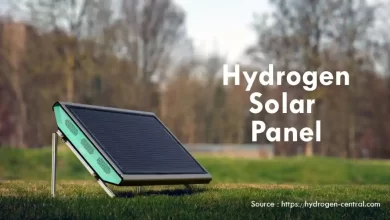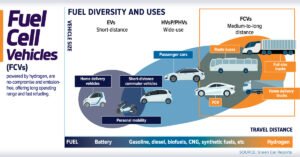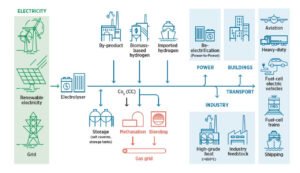Hydrogen as a Renewable Energy Source:
Exploring the Benefits of Photocatalytic Solar Panels In the face of climate change and the need to reduce our reliance on non-renewable energy sources, hydrogen has emerged as a promising option.
As the most abundant element in the universe, it has the potential to power our homes, cars, and industries in a clean and sustainable way.
In this article, we will explore how hydrogen is being harnessed as a renewable energy source, with a specific focus on photocatalytic solar panels and their benefits. What exactly is hydrogen and why it is being considered asa source of renewable energy.
Hydrogen is a colourless, odourless, and highly flammable gas that is found in water, plants, and other organic materials.
One of the ways It can be created is using a method known as electrolysis, which involves passing an electric current through water to divide it into hydrogen and oxygen.. The hydrogen produced through this method is considered renewable as it uses water as its raw material and does not emit any harmful greenhouse gases.
One way to harness hydrogen as a renewable energy source is through fuel cells. Fuel cells use hydrogen to generate electricity, with water being the only by-product. This electricity can then be used to power homes , offices, and cars. However, the production of hydrogen through electrolysis can be energy-intensive and expensive.
This is where photocatalytic solar panels come in. ‘photocatalytic solar panels’ are panels that use sunlight to directly split water molecules into oxygen and hydrogen without the need for external electricity’. Photocatalytic solar panels, also known as photoelectrochemical cells, use sunlight to directly split water molecules into oxygen and hydrogen without the need for external electricity.
This process is known as photocatalysis. When sunlight hits the panel, it triggers a reaction that splits water into oxygen and hydrogen, mimicking the process of photosynthesis in plants. So how exactly do these panels benefit us? Firstly, the process of directly harnessing hydrogen from sunlight is highly efficient and does not produce any emissions. This makes it a clean and sustainable energy source.




Additionally, the panels are made from readily available materials and do not require any costly infrastructure or maintenance.
This makes them a cost-effective and accessible way to produce hydrogen.
Another major benefit of photocatalytic solar panels is their versatility.
They can be used in a variety of settings, from individual households to large-scale industrial complexes.
This means that hydrogen can be produced locally and used to power homes and businesses, reducing our dependence on grid energy sources.
This local approach also reduces the risk of power outages and increases energy security.
Moreover, the production of hydrogen through photocatalytic solar panels can help with the integration of renewable energy sources into the existing energy grid.
As solar and wind energy are intermittent, hydrogen production can act as a way to store excess energy and provide a continuous supply.
This can help overcome the challenges of renewable energy, such as intermittency and variability.
In addition to being a clean and sustainable energy source, hydrogen also has the potential to revolutionise transportation. With the rise of electric vehicles, the demand for hydrogen fuel cell vehicles is also increasing.
These vehicles use fuel cells to convert hydrogen into electricity to power the motor, with water being the only by-product. This not only reduces carbon emissions but also eliminates the need for fossil fuels.
The use of hydrogen as a renewable energy source is still in its early stages, but the potential is immense. Various other applications, such as heating and industrial processes, are being explored. And with the development of new and more efficient photocatalytic materials, the cost of producing hydrogen through solar panels is expected to decrease even further.
In summary, hydrogen is a highly promising renewable energy source, and photocatalytic solar panels offer a clean, efficient, and versatile method for its production. By harnessing the power of the sun to produce hydrogen, we can reduce our carbon footprint and move towards a more sustainable and greener future.
It is important for us to encourage governments and individuals to continue to invest in and support the development of this technology, as it has the potential to play a significant role in our transition to clean and renewable energy.
References
Zhang, T., Guan, X., Zhu, B., Zhang, Z., Ye, X., Zeng, W., Gao, Z., & Guo, L. (2024, January 1). Boosting Solar-driven Thermal-assisted Photocatalytic . . . International Journal of Hydrogen Energy. https://doi.org/10.1016/j.ijhydene.2023.07.103


